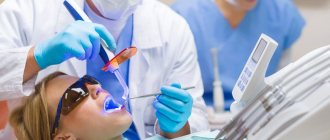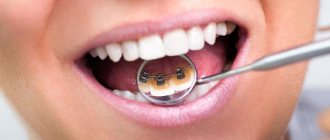Modern treatment of caries
Thanks to the constant improvement of techniques, today the diagnosis and treatment of dental caries is carried out at a high level, which allows for maximum preservation of healthy tissue. In addition, in situations where just a few years ago advanced caries led to mandatory tooth extraction, today tooth-preserving operations are performed. Among them are the following.
- Resection:
treatment of tooth root caries by removing the apex of the root. - Root amputation:
removal of the damaged root part of a two-rooted or three-rooted tooth. - Coronoradicular separation:
separation of tooth roots. It is carried out when caries has affected the tooth in the area of root branching. - Hemisection:
removal of the damaged part of a multi-rooted tooth and the adjacent crown area.
For those who are afraid to treat caries: treatment in a dream
Fear of dental treatment is a relic from the past, when dentists had not yet used advanced instruments and highly effective anesthetics that completely eliminated pain during medical procedures. All people understand this, but, alas, not everyone can overcome internal prejudices and overcome fear and panic in the doctor’s office.
When a patient is very frightened, he experiences stress, cannot sit calmly in the dental chair, and of course, this prevents the dentist from carrying out treatment and working with the tooth. Our dental clinic in Moscow, Firadent, offers such patients a special service - treatment of dental caries during sleep or, as professionals say, under sedation.
Sedation is a state of light medicated sleep into which the patient is immersed before the start of the treatment process. The use of sedation allows the doctor to perform all necessary actions without pain and without discomfort for the patient. You will sleep, and the dentist will cure caries, and in one visit you can successfully treat several teeth damaged by caries at once.
Sedation not only allows you to treat teeth without pain - it does not give any negative side effects compared to general anesthesia. You can find out more about the service of dental treatment in your sleep and its cost by reading the topical material on our website or by contacting the specialists of our clinic using contact phone numbers!
Indications for the treatment of dental caries
Indications are reduced to visual and tactile.
✔
Visual:
stains on the enamel, darkening of the cervical area of the tooth, chipping of part of the tooth and darkening underneath it, a dark border around the perimeter of the filling, a carious hole.
✔
Tactile:
aching pain when eating sweet, salty and sour foods, and acute pain from sudden temperature changes.
What are caries?
Caries can affect different parts of the tooth and according to the area of localization of carious damage, it is classified by type. Let's get acquainted with different types of caries and find out their characteristic features.
Cervical caries
It affects the neck of the tooth and develops quite quickly, because the natural enamel coating in this area is thin and often demineralized.
Cervical caries easily spreads to neighboring teeth and its main danger is that, if left untreated, pulpitis may occur, because the neck of the tooth is located quite close to the nerve of the tooth. By the way, for the same reason, a tooth with cervical caries can be quite painful. The treatment method for cervical caries is selected based on the stage of development of the disease. With medium and deep cervical caries, you cannot do without drilling the tooth, but if you see a white spot on the neck of the tooth and immediately contact the dentist, the tooth will be cured by remineralization or the infiltration method - icon technology.
YOU NEED TO REMEMBER! One of the reasons provoking the development of cervical caries may be the wrong choice of brush for cleaning teeth. A brush with hard bristles can damage thin tooth enamel. Frequent use of toothpastes with abrasive particles can have the same negative effect on the integrity of tooth enamel. From here we draw a simple conclusion: the choice of tools and materials for dental hygiene should be deliberate! If you don’t know how to choose the right brush and paste to keep your teeth healthy, come to our dental clinic in Moscow - “Firadent” and get from our doctors the most detailed professional advice on proper dental and oral hygiene!
Cervical caries requires urgent treatment, because the tooth is destroyed quickly and if the inflammation spreads to the pulp or root system, it will not always be possible to cure the tooth with conservative therapy. Sometimes, with deep cervical caries, a tooth has to be removed, and its subsequent restoration with prosthetics or implantation involves significant financial costs.
As an example and to motivate timely treatment of cervical caries or in any other form, let’s compare the prices for conservative therapy and implantation. You can cure average cervical caries in Moscow for 4-5 thousand rubles, the price of implantation starts from 50,000 rubles. The difference is huge, isn't it? Therefore, if you want to treat your teeth inexpensively, don’t delay visiting the dentist!
Types of caries by localization
fissure
It begins in the physiological recesses of the chewing teeth - fissures. The patient cannot detect it during self-examination.
Approximal (or contact)
It begins on the contacting surfaces of adjacent teeth. As a rule, this is a consequence of not using floss or irrigator as part of hygiene.
Cervical
It begins at the base of the gum, gradually destroying the neck of the tooth. It is the result of severe tartar.
Interior
It begins under the tooth filling if errors were made during its installation.
Under the crown
It begins under the crown if it does not fit tightly to the tooth, causing microscopic food debris to accumulate.
What can cause caries?
Caries occurs due to the proliferation and active activity of harmful microorganisms - bacteria - in the human oral cavity. In order for them to multiply and spoil teeth, a person needs to create an environment favorable for them.
It is possible to create ideal conditions for the reproduction and vital activity of pathogenic organisms in the following cases:
- oral and dental care is not performed or hygiene measures are carried out incorrectly;
- a person consumes too much sweets, drinks coffee and carbonated drinks;
- the body does not receive enough calcium, vitamins and essential microelements;
- a person has problems with the gastrointestinal tract;
- eating too hot or cold food.
Caries can occur even on completely healthy teeth. Bacteria multiply in the mouth very quickly and if you do not fight them, you can lose several teeth at once. A small hole forms in the tooth, then pain begins and the process spreads to the remaining teeth.
It is better to prevent the occurrence of caries than to try to treat something later, because it will be better for the person in any case.
Types of caries according to severity
Initial caries
Characterized by a change in the color of the enamel: the so-called white spot caries. Does not cause discomfort to the patient.
Superficial caries
Characterized by the appearance of dark spots on the enamel. The affected tooth may react weakly to cold, sour or sweet foods for a short time.
Average caries
Characterized by destruction of dentin. Painful sensations to external stimuli are more pronounced and last longer.
Deep caries
Characterized by damage to a large area of tooth enamel and dentin. The pain does not go away without the use of analgesics.
Alternatives to Remineralizing and Whitening Teeth Varnishes
Various gels, foams and toothpastes are actively used in dentistry to remineralize teeth. Moreover, remineralizing gels and pastes can be used at home. For example, ASEPTA PLUS Remineralization toothpaste with hydroxyapatite, plant extracts, papain and thermal mud helps strengthen teeth and gums and reduces sensitivity. This paste should be used as usual: twice a day for 3 minutes.
Gels for remineralization at home are used in courses. The gel is applied with a toothbrush or finger to all surfaces of the teeth, cleaned of plaque, and left for the time specified in the instructions. Such products can be used in conjunction with universal mouth guards. Remineralizing gels are safe if accidentally swallowed. Their use is indicated after professional cleaning procedures.
For whitening, you can choose a special toothpaste. The effect of its use is cumulative and long-lasting, unlike whitening varnishes for home use, but less pronounced. Professional whitening pastes allow you to lighten the enamel by several tones. Particularly noticeable results are achieved in conjunction with professional teeth cleaning. For effective and safe enamel whitening, we recommend ASEPTA Gentle Whitening toothpaste. The fluoride-free paste contains fine abrasive components that clean the enamel of plaque without leaving microcracks. ASEPTA toothpaste prevents the occurrence of caries and sensitivity.
Interesting products for teeth whitening at home - strips, foam, gel stick. Sticky whitening strips absorb and break down dark pigments and plaque from the surface of teeth, resulting in a lighter natural shade of teeth. You will get visible results within 7 days of regular use of the strips, the maximum effect is achieved within 14 days.
Additional oral care in the form of whitening foam is intended for hygiene throughout the day. Recommended use after every meal. Thick foam breaks down soft plaque even in the most difficult to reach areas, without the need for a toothbrush or water. The active components of the product act on the surface of the enamel and penetrate into its deeper layers, discoloring coloring pigments. Additionally, the product helps strengthen tooth enamel and reduce sensitivity. This is the best option for those who wear braces or other orthodontic structures.
A whitening gel pencil can lighten teeth by 2-4 shades within a week of use. The use of individual trays improves the result, since the gel must be kept on the teeth for 5–7 minutes.
Modern methods of treating dental caries
Today, there are several methods for treating caries, differing in the degree of surgical intervention - the earlier the degree of development of the disease, the greater the likelihood that it will be possible to get rid of it with few sacrifices.
Modern technologies for treating caries without preparation:
- Remineralization:
a procedure for treating enamel caries, which involves treating the tooth surface with a solution containing fluoride, phosphorus and calcium. The patient is also prescribed a number of medications to take orally. Helps in the treatment of white caries, or caries in the spot stage. - Infiltration:
chemical-mechanical treatment is also a method of treating caries without preparing Icon. It is used for initial caries and only on smooth surfaces or between teeth. First, a gel is applied to the carious area, which splits the affected enamel; the site of bacterial development is dried under the influence of ethyl alcohol and an air stream and treated with a polymer resin, which fills the enamel pores. The entire procedure lasts about fifteen minutes. - Air abrasive treatment:
“knocking out” superficial caries using a powerful stream of abrasive particles. The force of action is designed to affect only soft tissues affected by bacteria. The method is painless, and therefore there is no need for anesthesia. Air abrasive treatment reduces the risk of microcracks forming after treatment, in some cases it is even more effective than a drill. However, this method of caries treatment is not always applicable. - Ozone treatment:
destruction of caries bacteria using a natural antibiotic and oxidizing agent - ozone. Another method of non-contact treatment of caries. Ozone not only suppresses infection, but also has a remineralizing effect on tissue. During the procedure, a special device converts ozone from oxygen and supplies it to the affected area. Ozone destroys bacteria and is converted back into oxygen. The technology for treating caries with ozone allows you to leave healthy cells intact. Another advantage is that there is no need for anesthesia. The treatment time for caries using this method is less than a minute. Like the previous one, it is suitable only in the initial stages of caries or as its prevention. - ART technique:
restorative therapy, during which, using a special instrument, the affected tissue is removed and the cavity is filled with special dental cement. This method of treating caries was invented in third world countries, where it was not possible to open full-fledged dental offices, but it is also used in developed countries. Completely manual work allows you to act carefully and preserve as much healthy tissue as possible. - Laser treatment:
an effective technique for eliminating superficial and intermediate caries (for example, in the treatment of dentin caries) using laser fluorescence. During the procedure, a bactericidal solution is used, which cools the tooth and reduces pain. In addition, laser devices do not produce vibrations, which could increase pain. That is why the laser treatment method is indicated primarily for children and pregnant women. The laser selectively acts on the affected area, “evaporating” it, and disinfects the resulting cavity, thus eliminating the risk of developing secondary caries. - Treatment of dental caries with diet:
a method of treating caries naturally, developed based on the scientific theory of the American researcher Ramiel Nagel. According to his observations, caries does not have an infectious-bactericidal nature, but is associated with the weakening and destruction of enamel due to a lack of necessary substances. Therefore, the problem can be solved with proper nutrition. Adherents of natural treatment recommend actively using cod liver, fish caviar, butter and other products containing fat-soluble vitamins, nutritious broths, as well as chicken, beef and fish. It is better not to overuse fruits - due to their high sugar content - and combine them with small portions of fat, such as cream.
Silvering of teeth: advantages and disadvantages of the procedure
Coating children's teeth with silver is one of the most gentle technologies for treating childhood caries in the initial stages. This method is not new in dentistry; it has been used for many decades. The noble metal itself is not used in treatment, but only its active salts. The tooth surface treated in this way becomes denser and more resistant to food acids.
Silvering of teeth is effective only in the initial stage of the carious process, when it appears on the enamel as small spots. The technique is indicated for children under three years of age.
The positive aspects of the procedure include:
- an excellent way to stop the progression of caries on a child’s teeth;
- silvering does not cause negative reactions on the part of a young patient;
- The cost of the procedure is low, which makes it accessible to all patients.
The disadvantages of coating children's teeth with silver include:
- the formation of black plaque on the tooth surface, which does not create an aesthetic effect;
- For deep carious lesions, the technique cannot be used.
Dentists do not recommend silvering the front teeth, because the resulting black plaque causes psychological discomfort in the child. Along with this, there are other contraindications: allergies to the components of the drug, the patient has somatic diseases, in cases of dentin damage by caries and the child is over 3 years old.
Among the most popular drugs for the silvering procedure are domestically produced Argenate and Japanese Saforide. Both products have a therapeutic and prophylactic effect on tooth enamel and are completely harmless to the child’s health.
Classical treatment of caries in permanent teeth
In advanced cases, non-invasive treatment methods for caries will not help, so specialists turn to the old but effective removal of caries using drilling.
The procedure involves cleaning the affected canals using a drill; if dentin is damaged, pulp and infected tooth tissue can also be removed. It should be noted that the devices that are used for this today have gone far ahead of those that once brought fear to our grandparents. Anesthesia and disinfectants can reduce the pain effect and make the procedure more comfortable for the patient. To complete the treatment of caries, a filling or crown is placed on the tooth and adjusted so that the patient does not feel any discomfort.
Prevention of caries in children
Prevention of caries in children
Today, the most common human dental disease is caries. Caring parents should help their child keep his teeth healthy and relieve him of toothache. To do this, it is necessary to pay considerable attention to the prevention of caries.
Let's try to take into account the results of the latest research in this area in order to, at a minimum, achieve the European indicator - on average, less than two fillings by the age of 12.
1. You can start taking care of preventing caries in a child already during the mother’s pregnancy and breastfeeding. By taking special tablets containing only 1 mg of fluoride, it is possible to achieve a double effect: on the one hand, the fetus develops strong teeth, on the other hand, the woman’s body does not lose fluoride. And eat more calcium, that is, milk, cottage cheese and kefir, without frightening your family with uncontrolled eating of school crayons.
2. After the baby is born, it is important to maintain hygiene. First of all, dear parents, you should not prematurely transmit your bacteria (Streptococcus mutans), which, according to one theory, causes caries. Most often, these microbes migrate from the parent's mouth along with a licked spoon or pacifier. You should not do this - it is better to rinse or boil a fallen pacifier, rather than lick it. And then the child’s oral cavity will remain free of caries longer.
3. To prevent the appearance or development of caries, it is necessary to properly organize the family’s nutrition. Your child's diet should contain calcium from dairy products. This is not at all difficult, since children's yoghurts, milk and kefir are becoming tastier and more varied. In order for calcium to be better absorbed, vitamin D is needed, which is found in fish dishes and is formed under the influence of sunlight. So take sunbathing with your baby more often, go for walks, which will strengthen not only your teeth, but also your family friendships. In addition to calcium, fluoride is needed to prevent caries, which is added to toothpaste and some food products.
4. To prevent all your efforts to prevent caries in your child from going to waste, try to give him less sweets - they are the main destroyers of teeth. Streptococci, which are harmful to teeth, multiply on tooth enamel only in the presence of sugar, which they actually feed on. When bacteria process sugar, they produce acid, which destroys tooth enamel. Conversely, feed your child fresh fruits and vegetables as often as possible: the sugar and fruit acids they contain do not pose a danger to teeth. Or, as in Europe, choose for children only sweets with the safe sweetener xylitol.
5. The most reliable remedy against caries in children is a traditional toothbrush with good toothpaste. You should start brushing your teeth from the moment baby teeth appear - by maintaining their health, you will ensure your child the correct and timely germination of permanent teeth. It is very important for a child to develop the habit of brushing their teeth every day so that they realize and take responsibility for the health of their teeth as early as possible.
6. The child should be examined by a dentist twice a year. If, during the next visit to the doctor, a child is found to have incipient caries, fluoride varnish (fluoride varnish) or a silver fluoride compound can be used to protect the enamel from destruction. The procedure is absolutely painless and takes no more than one minute, and the effectiveness of this method for preventing caries is very high.
7. When the child has permanent teeth, it is advisable to make a special visit to the dentist to carry out another very useful procedure - sealing the grooves (fissures) of the teeth. It is advisable to do this procedure within a year and a half from the moment the molars erupt. As a result, after eating, plaque with bacteria that destroy the enamel will not accumulate on the chewing surface of the teeth. During the procedure, the doctor cleans the teeth with a brush and paste, and then applies an acidic substance to the grooves and pits on the surface of the teeth. After this, a sealant is applied to the tooth, which flows into the micropores of the enamel and solidifies there under the influence of a special lamp. The sealant not only seals the tooth, but also saturates the tooth enamel with fluoride, magnesium, and calcium ions for a long time.
Deep fluoridation
Fluoride is known to be an important element for maintaining dental health. However, until recently, the only way to replenish this element in the enamel was fluoride toothpaste. But its effectiveness is very low, and teeth are still subject to destruction. The lack of fluoride is especially felt by residents of those regions where there is a shortage of the element in drinking water and food.
Today, medicine offers a unique method for restoring tooth enamel and hard dental tissues - deep fluoridation. This procedure replenishes mineral deficiencies, reduces tooth sensitivity and prevents the growth of bacteria, which leads to caries. For children, deep fluoridation is of particular importance, since the formation of permanent teeth occurs in the child’s body. Insufficient intake of fluoride from food, as well as irregular oral care can contribute to the early destruction of tooth enamel. Using the deep fluoridation procedure, it is possible to increase its hardness by 10 times!
What is the deep fluoridation method?
This method is based on a series of chemical reactions - they produce microcrystals of calcium fluoride that fill microcracks in the enamel. The deep fluoridation procedure itself takes place in several successive stages. First, the dentist cleans your teeth with a special paste to remove plaque and tartar deposits. Then, with the help of an air flow, the teeth are dried and covered with a sealing liquid, which “seals” the enamel (highly dispersed calcium fluoride and magnesium fluoride). After this, drying is carried out again and copper-calcium hydroxide is applied. A chemical reaction occurs between the first and second layers, during which microparticles of calcium fluoride are released - they very easily penetrate into the deep layers of enamel. At the same time, copper compounds formed as a result of the reaction have a strong bactericidal effect. Due to the described interaction of elements, anti-caries protection occurs.
In what cases is deep fluoridation recommended?
This procedure is preventative and absolutely painless. It is aimed at long-term protection against enamel destruction and caries (the effect lasts up to two years). Therefore, it can be recommended to everyone who cares about dental health.
Deep fluoridation is especially useful in the following cases:
- to protect baby teeth in young children
- for teenagers whose body experiences changes associated with puberty, during which carious activity increases
- with fluoride deficiency due to poor diet or natural habitat
- with increased tooth sensitivity
- with thinning enamel
- before installation and after removal of braces
Due to the fact that the effect of deep fluoridation is quite long-lasting, it is enough to undergo the procedure 1-2 times a year. However, despite the obvious benefits of this preventive measure, we should not forget about other ways to take care of dental health - a balanced diet, regular brushing, systematic visits to the dentist, etc.
Dental cream Tooth Mousse - a powerful preventative agent
Water-soluble, sugar-free professional application cream Tooth Mousse contains Recaldent™ CPP-ACP (bio-available calcium and phosphorus) and has a pleasant taste (melon, vanilla, strawberry, mint). In the oral cavity, the active substances of the cream bind firmly to enamel, plaque, biofilm, and soft tissues, directing calcium and phosphate to where they are needed. The duration of action of the drug is only a few minutes, but the effectiveness increases with longer application.
Tooth Mousse Gel is used for:
normalization of the acid balance in the oral cavity (neutralizes waste products of dental plaque bacteria, neutralizes excessive acid when it enters the oral cavity from internal and external sources)
- Improved tooth surface cleaning
- increased salivation
- normalization of mineral balance
- restoration of tooth enamel structure
- prevention and elimination of caries in the initial stage
remineralization and reduction of sensitivity of dental tissues after teeth whitening, orthodontic treatment, professional teeth cleaning, curettage, tartar removal, additional protection of hard dental tissues
There are various ways to use the drug: in the dentist’s office with or without a mouthguard, or at home under the supervision of a doctor. The timing of use is set by the doctor, based on the individual and age characteristics of the patient. It is important to note that for successful caries prevention, the use of dental cream alone is not enough. The patient needs to adjust the diet, fill it with foods rich in microelements, reduce the consumption of sweet foods, and minimize the consumption of carbonated and sour drinks.
Since Tooth Mousse gel does not contain fluoride compounds, it can be used at any age, however, the drug has one contraindication.
Tus Mousse SHOULD NOT BE USED in patients allergic to cow's milk proteins because the active ingredient Recaident™ CPP-ACP is derived from cow's milk casein.
It is important to note that Tooth Mousse dental cream, containing the unique component Recaldent™ CPP-ACP, is not sold in pharmacies or stores and is available only in specialized dental institutions.
Preventive APF gel for teeth
Preventative APF dental gel for topical use in the oral cavity is becoming increasingly popular among Russians. Regular care of teeth and gums using preventive fluoride APF gel not only helps prevent caries, gum inflammation and hyperesthesia, but also, due to its high fluoride content, has a beneficial effect on tooth enamel.
According to international studies of dental research institutes, the preventive use of fluoride ACE gel reduces the incidence of caries by 65% among children and adults. Preventing caries with ACE dental gel also reduces the likelihood of secondary caries.
Prophylactic fluoride APF gel, when applied regularly, increases the hardness of the enamel by 10 times , and also significantly increases the service life of the fillings . Thus, regular prophylaxis using fluoride gel for teeth not only improves the health of tooth enamel and gums, but also leads to noticeable savings for the patient.
Thus, it is much easier and cheaper to prevent tooth decay than to treat them. Four basic strategies for preventing childhood caries and maintaining good oral hygiene include:
- use of care products with fluoride;
- regular visits to the dentist; professional oral hygiene
- elimination of all detected caries cavities;
- adjustment of diet and nutrition.
Author of the article: Nikolaeva Nargiza Shavkatovna
Dentist-therapist at dental clinics ZuboFF
Main stages of the procedure
If for caries in the stain stage, treatment comes down to brushing the teeth with a special brush, applying a remineralizing composition and taking medications to strengthen the enamel, then in later stages it is necessary to remove the affected tissue and fill the cavity. In this scenario, the principle of caries treatment is as follows:
- anesthesia;
- preparation of a carious cavity;
- removal of infected tissue;
- cavity treatment;
- tooth filling.
Caries treatment and filling are carried out in one appointment. If, during the treatment of caries, damage to the dental pulp is detected, it may require its removal.
Causes of caries development
Salivary fluid, if it is in sufficient quantity and of good quality, can completely neutralize the negative effects of all dangerous microorganisms in the oral cavity. This is how nature intended it; if saliva production is disrupted or if there are malfunctions in the body’s functioning, the protective properties are lost. If a person does not pay due attention to dental hygiene, a huge amount of bacteria accumulates on them.
As a result of their vital activity, acids are formed that gradually destroy tooth enamel. Those patients who eat large amounts of flour products, soda, and sweet drinks are most susceptible to tooth decay. Smokers are also at risk, because tobacco smoke forms a dense layer of plaque on the surface of the teeth.
Also, caries is most likely to appear in those who neglect the rules of cleansing the oral cavity, do not strive to compensate for the lack of nutrients in the body, like to eat very cold and hot food, do not visit the dentist for a preventive examination, etc. A general weakening of the immune system can also negatively affect the condition of the enamel.
Choosing a filling
Previously, mainly mineral cements, acrylic and epoxy, and amalgams were used to make fillings. Today, outdated fillings, which were imperfect in terms of fixation and aesthetics, have been replaced by modern inlays. They improve the adhesion strength to the tooth surface, do not require labor-intensive installation, and are biocompatible with the human body. Among them, the most used are: composites, glass ionomer cements, ormocers, compomers. Materials can be combined to achieve the desired effect.
More about the Keystone system
You have already realized the benefits of the procedure and the ease of its implementation, which means you are considering performing it on your child during the next visit to the dentist. Finally, a few more details about the Keystone system.
The principle of action of fluoride acid APF gel involves a chemical process of remineralization on the surface of the tooth. The Keystone fluoridation and caries prevention procedure for children is safe at any age and is designed to be performed regularly in the clinic - 2 times a year.
Make an appointment
Request a call
Is it possible to cure tooth decay at home?
Treatment of dental caries at home is impossible. However, this disease is preventable. To do this, you should regularly perform oral hygiene using calcium and fluoride toothpaste, visit the dentist twice a year and ensure that your diet contains enough proteins and fewer carbohydrates. For additional protection, you can apply gels to strengthen tooth enamel, which will saturate the teeth with minerals - they are not a cure for caries, but will help reduce the risk of developing the disease.
If it is too late to prevent caries, then herbal compresses and rinsing with strong tea will help temporarily reduce the intensity of pain. You can also press on the area between the lips and nose - there is a point there, the impact of which will send signals to the brain that distract it from the main source of pain. However, instead of diligently practicing traditional healing, it is better to turn to a professional as soon as possible. After all, only he will help you effectively cope with the problem.
Covering teeth in children: basic methods and their features
Children's teeth are often exposed to such unpleasant and rather dangerous diseases as caries and pulpitis. And not immune from
This is not a single child.
The enamel of a child's tooth is very thin and cannot fully withstand aggressive influences. For example, at night the child ate and fell asleep, and the bacteria ingested with food negatively affect tooth enamel until the morning. This pressure on a child’s teeth over a long period of time causes the development of “bottle caries.” What to do? How to protect your child's teeth? An excellent solution to this problem is offered by dentists at the Beryozka clinic in Balashikha and the medical clinic in Zheleznodorozhny - complete protection of children’s teeth by coating them with special preparations.
Cost of caries treatment in Moscow
The cost of caries treatment in each specific case is calculated individually and consists of several components:
- what type of filling will be installed;
- what type of anesthesia will be used;
- how much work the doctor has to do.
Thus, installing a filling on a chewing tooth affected by caries in state dentistry can cost 900 rubles, since it involves the cheapest composite material. The cost of a light filling in a private dental clinic in Moscow varies between 1500 – 2500 rubles. Treatment of caries of anterior teeth exceeds 3,000 rubles, since there are increased demands on aesthetics. As for anesthesia, local anesthesia starts at 300 rubles per tooth, general anesthesia starts at 2,000 rubles, and treatment with sedation, depending on its degree, ranges from 3,000 to 15,000 rubles.
Laser dental treatment without a drill
Treatment of caries with a laser, in other words, laser fluorescence, as well as the above methods, implies the treatment of caries without drilling in the sense in which we are accustomed to understanding drilling and the associated discomfort.
Why does unpleasant pain occur while the drill is working? The fact is that intense heating and friction occurs between the dental drill and enamel, dentin. And to these sensations is added vibration that spreads to the dental tissues. During laser treatment, tissue heating does not occur due to the low radiation power. In addition, laser devices are 20 times quieter than a drill! In this case, the main thing is not to accidentally fall asleep in the dentist’s office. It is not without reason that this method is recommended not only for people with increased sensitivity to pain and sounds, but also for those most sensitive to the perception of external stimuli - pregnant women and children. In addition, the procedure for laser treatment of caries is absolutely sterile - the tip of the installation does not come into contact with the teeth. The laser performs cavity preparation by selectively affecting caries, or, more precisely, only tissue infected with caries. The impact completely suppresses the growth of carious bacteria and eliminates the risk of secondary caries. At the same time, the laser method does not harm healthy teeth, and also does not lead to microcracks in the enamel. And the time spent on treating caries is reduced by about 40% compared to traditional treatment - there is no need to change attachments, and when treating superficial caries, there is no need to use anesthesia. Today, dentistry uses lasers not only as a method of treating caries, but also as a diagnostic method. The second is a significant advantage compared to X-ray diagnostics, since in the case of laser “checking” there is no radiation.
Disadvantages of treating caries without drilling teeth
- high cost of laser installation
- high demands on specialists working with lasers
- treatment requires the use of protective dark glasses by both the patient and the doctor
- glasses with tinted lenses can distort the reality and reduce the clarity of vision
- in some cases, soft tissue damage caused by lasers heals slowly and poorly
- there is also a possibility that the laser will be reflected from metal objects in the dentist's office, if they are not removed, and cause a fire










